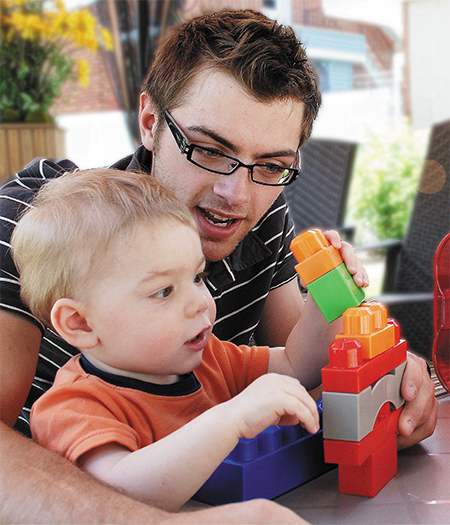Structure

![]() Having a routine and respecting boundaries helps your child develop.
Having a routine and respecting boundaries helps your child develop.
Photo: Florence Dion-Morin
The structure you provide for your child includes creating a routine and setting limits. Every child needs structure. Create a routine and set limits that you feel are appropriate for his age and needs.
![]() Your daily efforts to provide consistent structure will help your child in the years to come.
Your daily efforts to provide consistent structure will help your child in the years to come.
It’s best if different family members provide structure in a similar way.
Setting up a routine
A routine is a set of habits or actions that are regularly repeated in a child’s daily life. It’s established gradually. It’s different for each family.
Your child likes it when things are repeated in more or less the same order (e.g., snack time, bath time, story time, bedtime). You can also follow a morning routine (e.g., opening the blinds, hugging your child, then feeding him). He also likes actions or activities to be similar from one day to the next. You can sing the same song or tell the same story before bedtime.
![]() A routine is calming and reassuring for your child.
A routine is calming and reassuring for your child.
Children need a stable routine to help them understand what’s happening and what’s going to happen. A routine reassures and calms your child. Then he’s more open to connecting with you and developing himself.
![]() It’s normal for the steps of your routine not to happen at exactly the same time each day. It’s also normal not to follow your routine when there are special occasions or unexpected events.
It’s normal for the steps of your routine not to happen at exactly the same time each day. It’s also normal not to follow your routine when there are special occasions or unexpected events.
Setting limits
Although it can be difficult to set limits, your child needs them. As a parent, you’re preparing your child for life outside the home (e.g., daycare, extended family), where there are other limits and rules.
The purpose of limits
![]() Limits help children feel secure and confident. They also help children understand what’s expected of them.
Limits help children feel secure and confident. They also help children understand what’s expected of them.
Your child needs limits to feel secure and confident, even if they make him angry.
The limits you set are necessary to prevent him from hurting herself. For example, when your child first starts walking and gets close to a staircase, he has to hold your hand.
Limits also help your child gradually learn to respect other people and his environment. For example, once your child is able to use crayons, he is not allowed to draw on everything in the house.
How should I set limits?
![]() Parents don’t set all limits in the same way. The most important thing is to respect your child.
Parents don’t set all limits in the same way. The most important thing is to respect your child.
At first, you set limits by making the environment safe (e.g., you set up a barrier at the top of the stairs; see Babyproofing). Gradually, your child will also understand your instructions. At about age 1, he begins understanding very simple rules (e.g., “Stay here”).
The sentences you say to your child should be short and concrete (e.g., “Give me your hand”). Your instructions and expectations will change as your child gets older and more independent.
If your child doesn’t seem to understand, you can use gestures (e.g., motioning with your hand to say “come on”) or show him the behaviour you want (e.g., petting a cat without hitting it).
Sometimes, even if your child understands your instructions, he won’t follow them. He can’t control his impulses yet. He also needs to test the limits he’s in the process of learning. To help him, repeat the same instruction often in different contexts (e.g., he shouldn’t hit his parents or other people). Also, try to respond the same way to the same behaviours (e.g., tell him to speak quietly every time he yells).
When you set limits consistently, it makes it easier for your child to respect them. He will gradually learn to follow the rules with your help and by observing how others behave around him.
What should I do when my child doesn’t respect limits?
A good way to help your child when he doesn’t follow your instructions is to direct him to another action or activity. For example, if he’s trying to rip off a plant’s leaves, you can calmly say “no” and direct him to a game he likes.
When your child reacts strongly to a limit, you can name his emotions, showing him that you understand how he feels. Tell him that what he wants is not possible right now.
You help your child by demonstrating and encouraging the expected behaviours, rather than punishing her. If your child throws his spoon while eating, he will learn better if you tell him to “keep your spoon” than if you punish him by taking his snack away. Punishment doesn’t show your child what you expect of him.
If you have any questions or concerns about providing structure or about the intensity of your child’s reactions, don’t hesitate to contact a healthcare professional.
![]() Physical punishment (e.g., spanking, slapping, hitting) and behaviours that humiliate a child (e.g., insults, putdowns) are detrimental to the child’s health, safety, and well-being. These practices must not be used and are governed by Québec law. For help, please see the Resources for parents section.
Physical punishment (e.g., spanking, slapping, hitting) and behaviours that humiliate a child (e.g., insults, putdowns) are detrimental to the child’s health, safety, and well-being. These practices must not be used and are governed by Québec law. For help, please see the Resources for parents section.
What should I do when I’m angry?
Most parents find it challenging to set and maintain limits when their child isn’t respecting them. If you feel your anger building up, you can calmly let your child know (e.g., “I’m starting to lose my patience” or “I need to calm down”), even if he doesn’t understand yet.
You can ask someone else to look after him or make sure he’s safe (e.g., in bed) and leave the room for a few minutes. By doing so, you prevent impulsive, hurtful, or violent behaviour.
A parent’s yelling and angry gestures are stressful for a child. He won’t learn as well what you expect of him if he’s stressed. By staying calm, you’ll manage the situation better, and your child will maintain his confidence in you and himself. He’ll see that he’s still loved, even if you don’t agree with what he’s done.
If you lose your temper, you can apologize to your child, even if he doesn’t understand yet. That way, you’re setting a good example for him.
Encouraging your child

![]() Encouraging your child with a smile or a kind word is beneficial from the very first months.
Encouraging your child with a smile or a kind word is beneficial from the very first months.
Photo: Sarah Witty
Your child is learning. He needs you to be supportive and patient. Give your child more positive attention than negative, with lots of praise and encouragement. It’s better to highlight his efforts and celebrate his progress, rather than focusing on his struggles and undesirable behaviours.
Your encouragement lets him know what your expectations are and reassures him about his abilities and skills. Through his day-to-day experiences, your child will build his self-esteem and a positive sense of self-worth. Encouraging your child with a smile or a kind word is beneficial from his very first months.
![]() It’s normal for you to be more encouraging and patient on some days and less so on others. Being a parent is challenging. You’re learning, too.
It’s normal for you to be more encouraging and patient on some days and less so on others. Being a parent is challenging. You’re learning, too.


